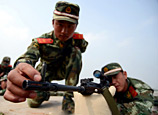
Expanding concept
Art has been expanding in its concept and in different media forms. Zhao said the development in space art and the growing number of public art exhibitions as well as discussions reflects the increased need of the public.
Art fairs are usually seen as snapshots of the galleries from different regions. Art Beijing, according to Dong, although it has not yet fulfilled its goal of "serving all Asia," can represent 90 percent of the galleries in China at the moment.
Early this year, many media outlets reported the financial difficulties that many galleries in the capital's 798 Art Zone are suffering. However, Zhao explained that industry insiders are very positive about the development of galleries.
Yet, the business model of often limited starting investment and high operation costs makes galleries hard to maintain in the industry. Many galleries, especially those that transformed to galleries from other business, have found a way for survival.
"In the past, 100 galleries were just like 10 galleries because they were all offering similar things. Now, everyone is different," said Dong.
"Many galleries are becoming more international, learning from experienced foreign counterparts," said Zhao.
The secondary market, mainly the auction houses, has played a dominant position in the past. Recently, as the primary market, including galleries and art fairs, develops, growth in the art market has slowed, making a healthier change in the industry.
Dong said the massive and non-regulated growth in the past was not normal. "Some galleries and painters complained about the economic situation. I would say they've been developed 'too well' in the past … the overall market will grow year-on-year and for galleries, the most important thing is to improve their services and develop real consumers in the process."


















 Matchmaking websites crack down on user fraud
Matchmaking websites crack down on user fraud


![]()
